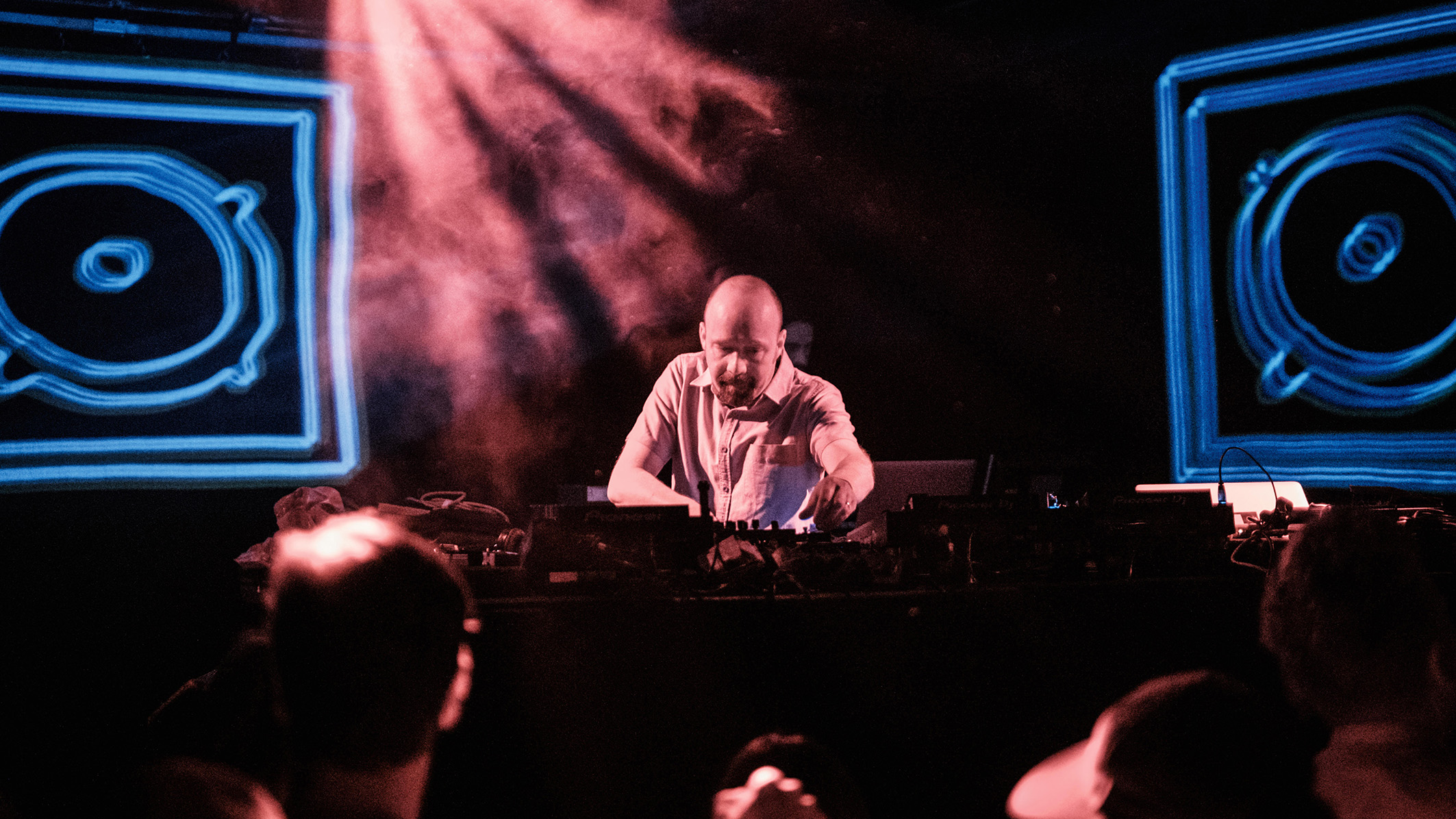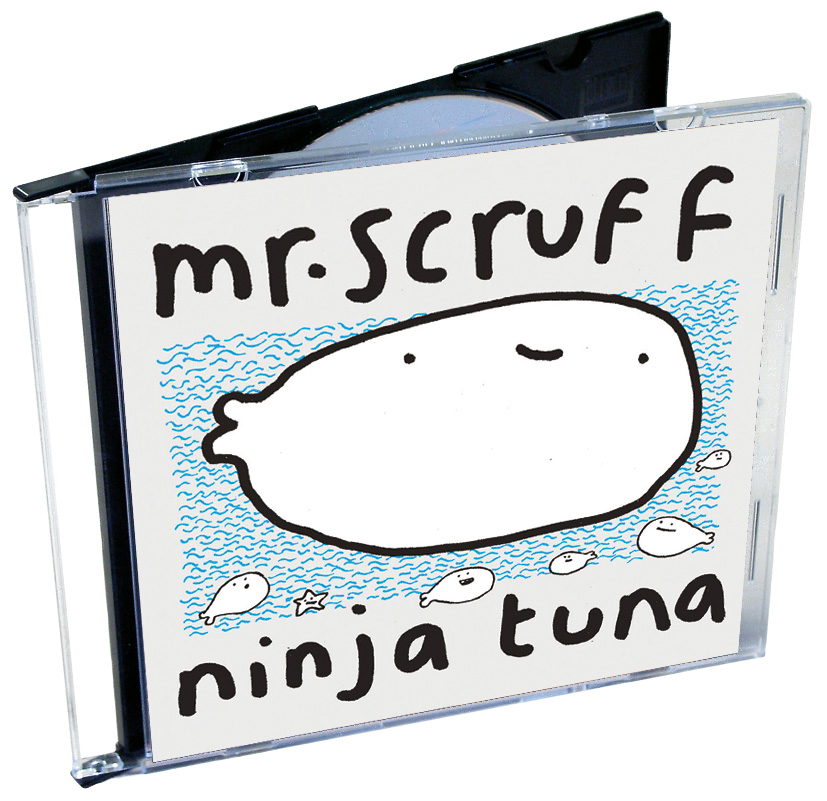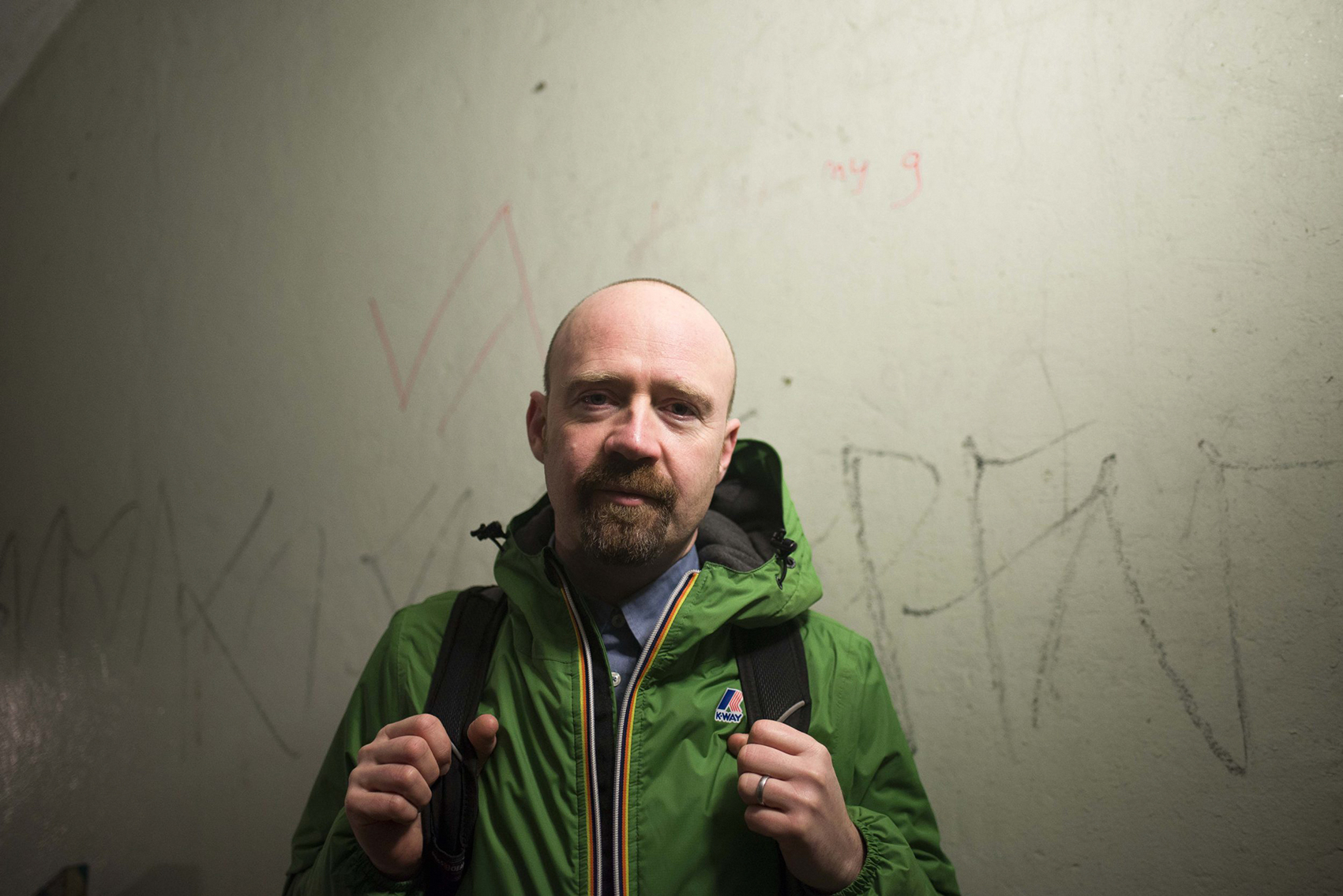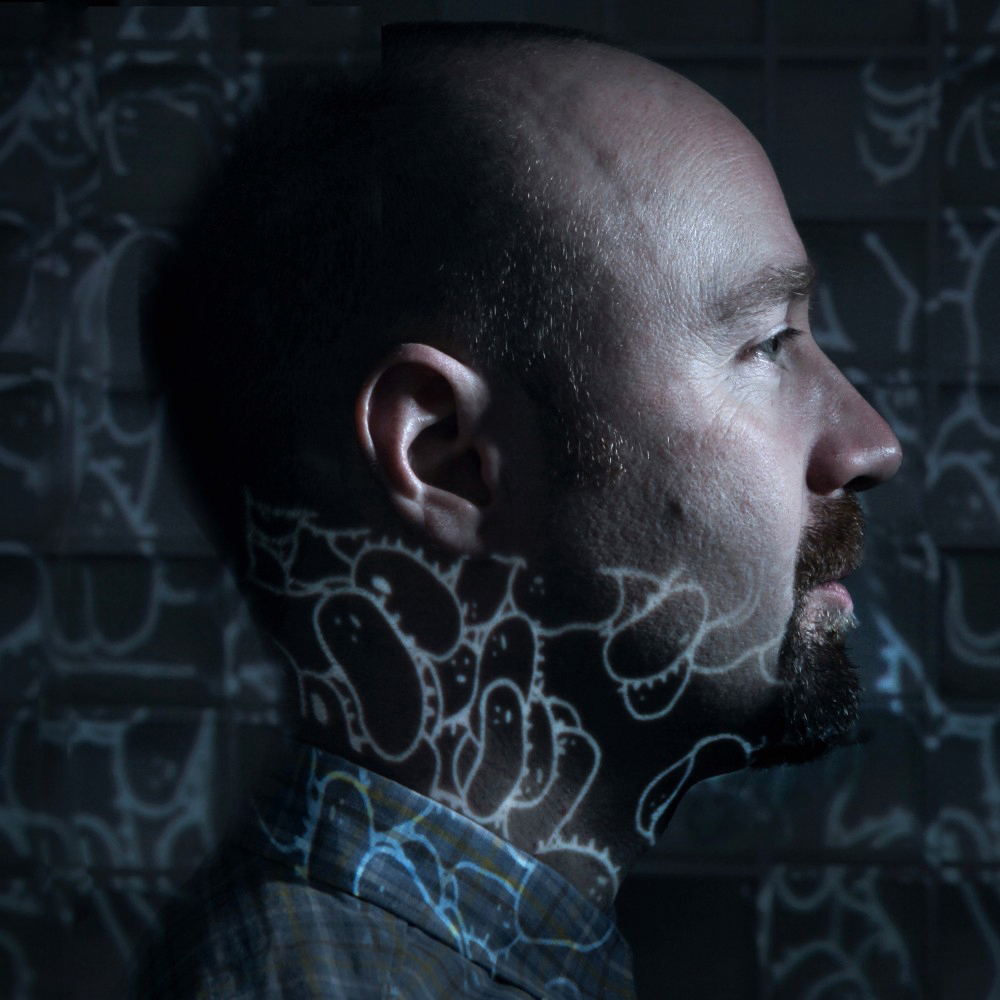"The main synths were the Juno, Moog Voyager and the Roland SH-5, which we used for the squelchy bottom-end. It’s like a spaceship, you know?": Mr. Scruff on Ninja Tuna
Mr. Scruff takes us back to 2008 for the making of his eclectic, gloriously silly Ninja Tune debut

By this, his third album, Mr. Scruff was on a roll. After coming out swinging with his first few LPs and signing to Ninja Tune, he’d cemented his reputation as a beat-maker extraordinaire.
His calling card? His silly sausage sense of humour, and seriously eclectic taste in music. Both of which are found in spades across Ninja Tuna. From the trademark fishiness of the title, and self-penned cartoon cover, to the broadest beats and glorious grooves he tucks inside.
Musically, the album takes cues from his all-night DJ shows, where devoted dancefloors regularly lost themselves to impeccably mixed jazz, breaks, funk, disco, hip-hop and house. He covers all those bases (with added bass) and more, across the album’s tracks. “It’s like a DJ set,” he explains. “But, in the studio. Trying to find those different shades and moods, to make a cohesive body of work.”
The studio, fittingly located in Manchester’s former textile industry, was where Mr. Scruff stitched together his rich tapestry of tracks. Assisted by long-time engineer, Phil Kirby. And multi-instrumentalist and studio ally, Andy Kingslow. Scruff worked quickly, fleshing out ideas and running in ideas off vinyl, seeing what stuck.
“I was still sampling, but also working with a lot of musicians,” says Scruff. “But, the two seem to sit really well on this album. “And, because I’ve worked with Phil since the early ’90s. And with Andy being so great to bounce off. It just gave the whole process a lot of momentum.”

It was happy time, and it shows, with guest rappers, singers and producers including Roots Manuva, Alice Russell and Quantic never failing to meet Scruff’s super jolly levels of fun and funkiness.
I was just having lots of fun with all the collaborators
“I was just having lots of fun with all the collaborators,” says Scruff. “And it really helped, working in a studio that wasn’t mine. I’d tram down and do a proper nine-to-five, making sure I was well-prepared. It’s not like making music in your own house. And then getting distracted by the washing up.”
Want all the hottest music and gear news, reviews, deals, features and more, direct to your inbox? Sign up here.
Ninja Tuna has just been reissued for the first time on triple-vinyl, and is available from Mr. Scruff’s Bandcamp page.

“With albums, I just get into the role of going in the studio. I don’t really think about what kind of music I’m going to make. I just do as much as I can. Throwing myself in, and being as free as possible…
“I do loads of tunes as quickly as I can, and finish them. Then, when I’ve got about 10, just stand by what I’ve got.
“It’s then that you end up with a direction, as well as adding a bit of a surprise. Because, you’re like, ‘Oh, wow – I never even realised that was happening!’”
Track by track with Mr. Scruff
Test The Sound
“It’s an intro. Almost like off an old hip-hop album or something. It was also a statement of intent, because, from the late ’90s, I’d been getting into what Phil [Kirby] called a kind of macho bass thing. And this was just a little bit of a very rolling, heavy little taster, you know? But, with a bit of a childhood vocal, some heavy drums, and a daft Moog bass.
“I always like to start this way. I think I just got myself into a little thing, you know? Same with all the fish tunes. Like, ‘I’ll just do one of those every album’, you know what I mean?”
Music Takes Me Up
“This track features Alice Russell on vocals. I’ve had a very long working and friendly social relationship with her through Tru Thoughts. She’s really funny, and she obviously has got an amazing voice.
There’s also a fruity middle bit, where the loops go off, like a kind of primary school Steve Reich
“For this, we decided to do a song about music – just an uplifting, jolly thing. But the music was also kind of tough and rolling. I played some one-finger keyboard stuff. Andy [Kingslow] played some nice Hammond organ. He’s a virtuoso in so many styles of music.
“Then he went back and forth with Alice on the vocal harmonies, and took her a little bit outside her normal range and normal tonality. What makes this such an intriguing tune is that harmonic depth.”
Donkey Ride
“This is with Quantic. He’s amazing. We’d done a few tunes together, by then. He came up to Manchester, brought his bass, and played guitar.
“Him and Andy were jamming, and I was chucking samples in and getting involved. Kind of directing. I liked that, because I had Andy, who was this very talented session musician, on tap. It was nice to step back from the process as things were being tried out and say, ‘Yeah, that!’
“Andy played that montuno-style piano in the middle, which gave it a really nice flavour. We’d do a maximum of two takes. I like to capture everything quickly, as it’s being figured out. It adds a very human feeling.”
Hairy Bumpercress
“The live bass here is from Jon Thorne, who’s best known for his work with Lamb. He’s completely on it, all the time. He’s crazy about music. I love working with people who are, yeah, just a bit crazy. It’s about capturing some of that energy on the track.
“We were stamping around on the floorboards and recording that. It worked with the double bass – that wooden sort of resonance. Then Andy’s on the keys and the Wurlitzer, which is beautiful on this.
“There’s also a fruity middle bit, where the loops go off, like a kind of primary school Steve Reich. Then it suddenly snaps back in. It’s like being dragged backwards through a forest for a minute.”

Whiplash
“This is one of the tracks on the album where I did most of it. For the drums, I got very ‘scientific’, as Danny Breaks calls it. But keeping the momentum and keeping it rolling. You don’t want to be tricky for the sake of it.
“With this tune it’s all ‘on/off’. You know what I mean? So, you’ve got, like, two bars of something happening, musically. And then there’s something a bit complicated, answering it. You know?
“It gives it this established structure, in terms of a little bit of a call and response.
“Then there’s the [Roland] SH-5 on top, which was mad. That was me, just properly making friends with that, over the beats.”
Nice Up The Function
“Roots Manuva is on this. I just wanted to do something really sparse for him, especially after the previous tune, which was just like [makes hectic noises].
“All the tunes up to this point in the album have been quite dense. Not necessarily complex, but quite full, in terms of fat sample breaks, room noise, and that rolling style.
“Here, I wanted to pull it apart, and have more of a skeletal thing going. And, because of how Rodney [Manuva] is… He’s mega off-the-cuff. And he’s got such a rich, round voice. His whole swing, and his way with language, and all this kind of thing. I just wanted to give it a lot of space.”
Bang The Floor
“I did this one with Danny Breaks. He’s great – obviously with his drum ’n’ bass stuff, but, also, that formula of proper fat hip-hop drums with the bass that you just couldn’t mess with.
“There was a recognition of, like, ‘Alright, we’re both spending quite a lot of time in this musical territory’. So, he came up to Manchester and we got jamming.
“Danny would be playing stuff. Andy would be playing. And we’d be tweaking all the filters on the SH-5. You can’t automate. And the whole front panel is quite complicated.
“Andy had a funky bassline going and both Danny and I would be all over the filters going [makes squelchy noise]. It was a lot of fun.”
Get On Down
“This uses a version of a tune called A Star In The Ghetto. It’s a Prince Phillip Mitchell tune, but this is a Johnny Adams version. He’s an amazing vocalist.
“I was listening to an obscure modern soul CD in the kitchen when it came on. That little ‘Get on down’ bit just jumped out. The whole tune’s amazing, but it was like, ‘Ooh, that’s nice’.
“I just started chopping it up. And, you know, with a sample, it’s just how you bounce off it.
“Obviously, my general first thing is to get some drums going, and then start to jam. Then get a couple of matching sounds. Because, sonically, the sample sets the tone."
Hold On
“Andreya Triana sings on this. She’s got such a distinct, smoky voice, I’d describe it as. And she’s able to reach a lot of different emotions and moods, which I admire.
“I looped up a Claudja Barry tune. This slow, European, chunky disco thing. I built up the beat, added bass, and kept it simple.
“Then there’s a little horn line running through it that I chopped up. There are a few different sections. When I’m working with a sample, I’ll have two or three options to choose from. Sometimes, you let it roll. And, other times, I’m going to switch it up, halfway through.
“Andy plays Wurlitzer. And there’s amazing trombone from Nichol Thompson, augmenting the horns that were there already.”
Give Up To Get
“What I did here, was something I often do in the studio. I just get a nice loop going, then play something quite floaty over the top that doesn’t have a lot of percussive elements.
“The turntable in the studio was a belt-drive hi-fi deck, so you couldn’t pitch it to match. You just play stuff, and it drifts over the beats.
For this album, that’s the recurring motif. The arrangements are quite involved. And there’s a lot of progression. But, it’s still very danceable and listenable
“It might be a little bit behind, or a bit slinky and rubbery. But, that feel and how it interacts with the other things around it, gives it that slight mismatch. And, that’s the groove, isn’t it?
“Obviously, you’re hoping for some kind of serendipity. So, I always record it, as it’s playing.”
Kalimba
“I got a nice beat together, and Andy played a lot on it. There’s lots of me and him, jamming and communicating a lot. It came together quite quickly.
“Then, Andy had the idea to add some strings, and got his friend Pete Whitfield in. He brought in a violin and stood in different positions in the room with one mic. He’d obviously done this before. And it got that full string section sound. He’s a great arranger.
“It’s quite catchy and jolly. But, there’s lots of complexity in there as well.
“For this album, that’s the recurring motif. The arrangements are quite involved. And there’s a lot of progression. But, it’s still very danceable and listenable.”
This Way
“Pete Simpson – what an amazing, amazing vocalist. Same again, dead easy-going and lovely person.
“I think he was living in Austria. I sent him all the parts. And the beat was quite simple. And he was just crazy with the harmonies.
“And then Andy and I really sort of fleshed out what he’d done, because harmonically he knows exactly what he was doing.
“I just smile when I remember working on that track, just because of the richness and the soulfulness of his voice.”
Stockport Carnival
“This is another one where Andy played a lot of stuff on it. He played the piano. And I suppose it ended up as this weird, vaguely Latin, hip-hop thing. He played that nice little rolling piano riff. And I built a beat around that. And then we just got some musicians in.
“So, Ricky Weedon is on percussion, and there’s Paul Farr, who’s a ridiculous guitarist. He came in and played on that, and a lot of his amazing solos were one take.
“Then, Bernard Moss is on flute, who I’ve known since his days in Pork Recordings. Neil Yates is on trumpet. And an amazing trumpet and flugelhorn player, James Knight, who’s another ridiculous, very fiery, very funny chap.
“It was all fluid and beautiful, and everyone really helped to pull the whole track together.”
In the studio with Mr. Scruff

“The main synths were the Juno, Moog Voyager and the Roland SH-5, which was used for a lot of the squelchy bottom-end on the album. Yeah, it’s like a spaceship, you know? It’s amazing bit of kit. And, the other keyboards were the Wurlitzer, Rhodes, and Hammond.
“And then lots of nice outboard [effects], as well. So, Distressors and Avalon EQs. A Manley VOXBOX. And those big Manley Massive Passives, and summing mixers.
“The software was Logic. The main thing, for me, working in Logic is we weren’t really using MIDI, or anything like that. It was more just recording audio, you know?
“Most of the keyboards in there were MIDI’d up anyway. So, it’s more just jamming, and then recording the bass, guitar, trombone, strings, whatever. And then just hacking and chopping.
“And the same went for all the samples. I was recording audio in from a deck, and then just sort of chopping it up. Yeah, audio rather than triggering – kind of old-school MIDI sampler-style.”
Mr. Scruff has just given his classic album Ninja Tuna a fancy reissue makeover. Originally released as a CD in 2008, it’s now available for the very first time in a deluxe triple-vinyl package. It comes with six bonus tracks from the era, and an “infinity peelable” sticker of a cartoon fish on the cover. Head to his Bandcamp to bag a copy, where we’re jokingly informed each pressing contains “sprout trimmings, hair, pastry flakes and biscuits”.



